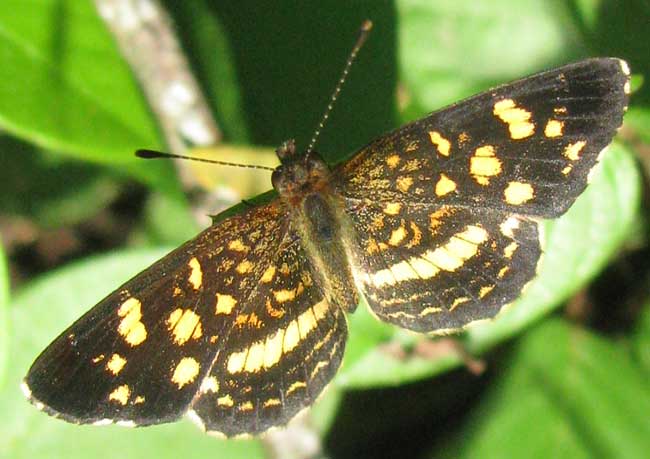Excerpts from Jim Conrad's
Naturalist Newsletter

from the January 10, 2010 Newsletter issued from Hacienda Chichen Resort beside Chichén Itzá Ruins, central Yucatán, MÉXICO; limestone bedrock, elevation ~39m (~128ft), ~N20.676°, ~W88.569°
TULCIS CRESCENT BUTTERFLY
Currently during the early dry season as the leaves of certain herbaceous trees and bushes are turning yellow or brown, curling up and falling, while relatively few plants are flowering, you just don't see many butterflies. Still, from time to time one flits by, as proven by the 1-¼-inch wide little critter shown above.
Bea, my volunteer butterfly-identifying expert in snowy Ontario, has been suffering butterfly-ID- withdrawal pains, so she jumped at the opportunity to tell me that what's shown above looks like the Tulcis Crescent, ANTHANASSA TULCIS, a species distributed from Argentina north through Central America and Mexico to southern Texas, sometimes straying to western Texas and southern Arizona.
Tulcis Crescents lay their eggs in batches on the undersides of leaves of plants in the Acanthus Family, especially the genus Dicliptera. Several members of the Acanthus Family are common in our local forest. The butterflys' caterpillars feed in groups at night, its adults take flower nectar, and mainly the species is found in open fields and second growth.
Anthanassa is a big genus in a big tribe (Melitaeini) in a very big subfamily (the True Brushfoot Butterflies, the Nymphalinae) in a huge family (the Brush-footed Butterflies, the Nymphalidae). During our wanderings we've run into several species in this same group.
So, I go to my Newsletter Butterfly Index page at www.backyardnature.net/n/ins-butt.htm and click on the names of other crescents I've seen and photographed. There's the honey-spotted Field Crescent from last summer in Oregon's Siskiyou Mountains, and the bruised-orange Pearl Crescent found on a levee in a swamp in Mississippi last March. Seeing and remembering these, I savor "variations on the Crescent Theme." It's like hearing a Bach fugue where a stated melody is shifted into different keys, toying with this and that note. In the end the whole variation-on- the-theme experience leaves me dazzled by Nature's general exuberance and the sheer delight She takes in jazzy experimentation, ornamentation and fooling around.